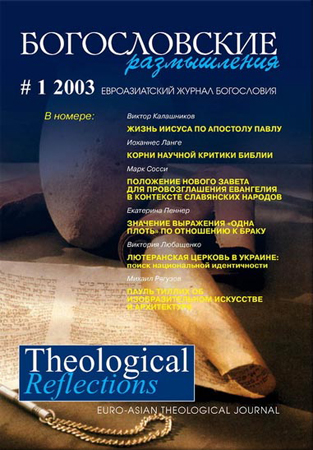The Significance of «One Flesh» in Relation to Marriage
Keywords:
One Flesh, nature of marriage, creation of humanityAbstract
This article deals with questions about the nature of marriage, the unity of spouses in marriage, and divorce as a phenomenon of the Fall, based on an analysis of the concept of «one flesh.» Primary attention is devoted to the creation of humanity and the original institution of marriage, where the phrase «one flesh» occurs for the first time. It is followed by an analysis of other biblical passages that directly refer to the expression «one flesh.» The goal of marriage is the unity of partners, which is possible due to certain covenantal conditions of leaving previous priority relationships, a strong connection between partners, and the uniting of all areas of their personalities. As marriage is a covenantal relationship comparable to the one between God and his people, the renewal, restoration and adaptation of the covenant for the benefit of each of the partners is always possible, even in the case of covenant violation.References
- Avot. Moscow, 1990.
- Agada. Moscow, 1993.
- Getz, G. A.. Chto takoe brak? Biblejskoe obnovlenie. Slavic Gospel Association, 1991.
- Gerts, J. Piatiknizhie i Gaftarot. Moscow and Jerusalem, 1999.
- Platon. Sochineniia. Moscow, 1993.
- Shchedrovitskij, D. Kniga Bytie, Vvedenie v Vetkhij Zavet. Moscow, 1994.
- Shneerson, M. M. rebe. K zhizni, polnoj smysla. Moscow, 1999.
- Khrabe, P. «'Novyi zavet' v Poslanii k Evreiam i ego znachenie dlia iudeo-khristianskogo dialoga» Khronograf 1-2 (5-6). 2000.
- Atkinson, D. To Have and to Hold. Grand Rapids, Michigan: Publisher? , 1979.
- Bilezikian, Gilbert. Beyond Sex Roles. Grand Rapids, Michigan: Publisher? 1989.
- Blomberg, Craig L. “Marriage, Divorce, Remarriage and Celibacy: An Exegesis of Matthew 19:3-12.” Trinity Journal 11:2 (1990).
- Brown, Colin, ed. The New International Dictionary of New Testament Theology. Grand Rapids, Michigan: Publisher?1975-1978.
- Brueggemann, Walter. “Of the Same Flesh and Bone” (GN 2,23a). Catholic Biblical Quarterly 32. 1970. http:/proquest.umi.com. 16 January 2000 г.
- Fee, Gordon. The First Epistle to the Corinthians. NICNT. Grand Rapids, Michigan: William B. Eerdmans Publishing Company, 1987.
- Garland, D., Richmond Garland D.S. Beyond Companionship: Christians in Marriage. Philadelphia: Publisher?,1986.
- Grenz, S. J. “Theological Foundations for Male-Female Relationships.” Journal of the Evangelical Theological Society 41:4 (1998).
- Guenther, A. “On Making and Breaking Covenants.” Direction 19.1 (1990).
- Hamilton, V. P. The Book of Genesis: Chapters 1–17. NICOT. Grand Rapids, Michigan: William B. Eerdmans Publishing Company, 1990.
- Heth, W. A. “Divorce and Remarriage: The Search for An Evangelical Hermeneutic.” Trinity Journal 16:1 (1995).
- Heth, W. A., and G. J. Wenham. Jesus and Divorce. Nashville: Publisher?,1984.
- Jenson, P. P. dj;a, // Dictionary of Old Testament Theology & Exegesis, vol.1, ed. W.A. VanGemeren. Carlisle: Publisher? 1997.
- Keil, C. F. The Pentateuch. Commentary on the Old Testament by Keil-Delitzsch. Grand Rapids, Michigan: William B. Eerdmans Publishing Company, 1996.
- Laney, C. J. The Divorce Myth. Minneapolis: Publisher?, 1981.
- Louw, J. P. and E. A. Nida. Greek-English Lexicon of the New Testament Based on Semantic Domains. New York: Publisher?1988.
- Luck,W. F. Divorce and Remarriage: Recovering the Biblical View. San Francisco: Publisher? 1987.
- MacLeod, D. J. “The Problem of Divorce.” Emmaus Journal 1:2 (1992).
- Malina, B. J. and R. L. Rohrbaugh. Social Science Commentary on the Synoptic Gospels. Minneapolis: Publisher? 1992.
- Moore, G. F. Judaism. Peabody where? Publisher?, 1997.
- Neusner, J., et.al., ed. Encyclopedia of Judaism. New York: Publisher?1999.
- Reiser W. „Die Verwandschaftsformel in Genesis 2:23.“ In Theologische Zeitung 16. 1960: 1-4.
- Sailhammer J. H. Genesis. The Expositor’s Bible Commentary, ed. F. E. Gaebelein. Grand Rapids: Publisher? 1990.
- Sarna, N. Genesis. JPS Thora Commentary. Place? Jewish Publication Society, 1989.
- Stedman, R. C. “A Response to Divorce and Remarriage.” In Applying the Scriptures, ed. K. S. Kantzer. Grand Rapids: Publisher? 1987.
- Von Rad, G. Genesis. The Old Testament Library. Philadelphia: Publisher? 1956.
- Wenham, G.J. Genesis 1-15. Word Biblical Commentary. Waco: Publisher? 1987.
- Westermann, Claus. Genesis 1-11. Tr. J. J. Scullion. London: Publisher? 1984.
- Wolff, H. W. Anthropologie des Alten Testaments. Munich: Publisher? 1990.
- Yamauchi, E. M. “Cultural Aspects of Marriage in the Ancient World.” Bibliotheca Sacra 135, #539. 1978.
Downloads
How to Cite
Issue
Section
License
Copyright (c) 2020 Katharina PENNER

This work is licensed under a Creative Commons Attribution-NonCommercial 4.0 International License.
All articles published in the Journal are distributed under a Creative Commons Attribution-NonCommercial 4.0 International License
By submitting an article for publication in Theological Reflections: Eastern European Journal of Theology the author grants the editors the right to publish the article and distribute it in electronic and print form.
The author reserves all copyrights and the right to use the materials of the article in whole or in part for educational purposes, to write his own dissertations, to prepare abstracts, conference reports, oral presentations, etc., as well as post electronic copies of articles (including the final electronic version downloaded from the journal’s official website) on non-commercial web-resources without the consent of the editorial board and founders.



